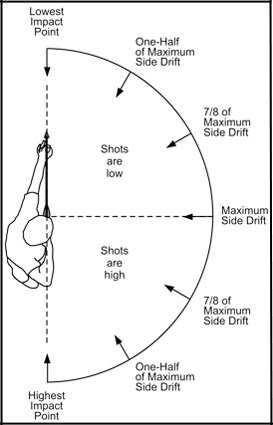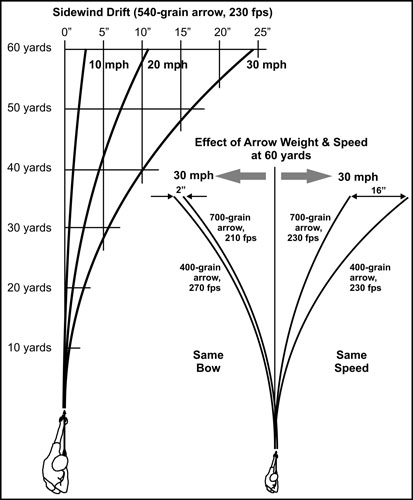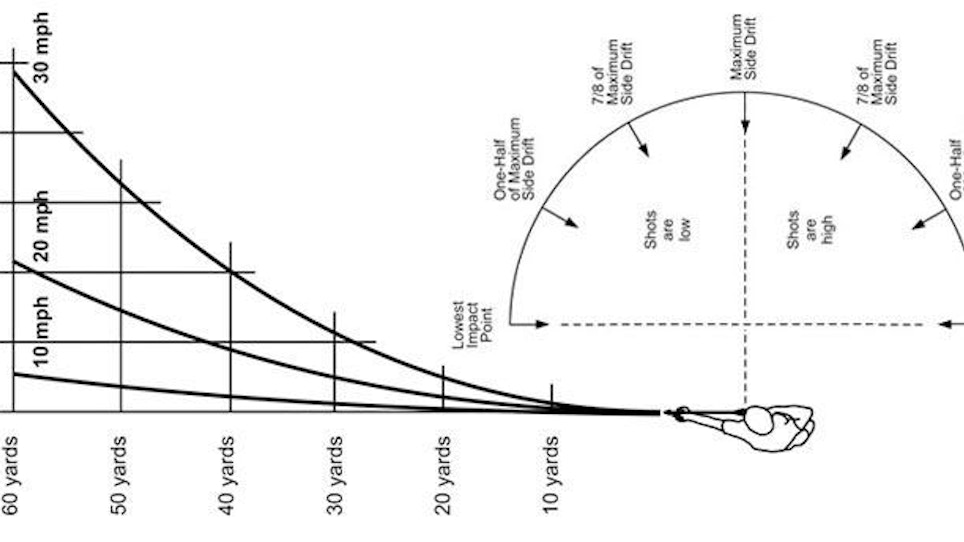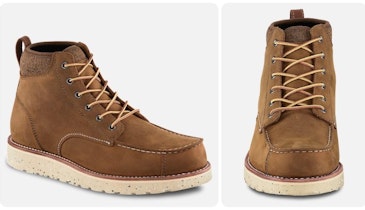 Wind Clock. Wind can dramatically affect a well aimed arrow. Even winds that are coming at you from 1:00 o’clock or 5:00 o'clock can produce half the drift of direct crosswinds. |
Wind is something that all archers have to contend with from time to time. It does two things to an arrow. Headwinds or tailwinds cause it to shoot high or low, and side winds cause it to drift away from your aiming line. In ballistics jargon, direct headwinds and tailwinds are known as low-value winds since they have the smallest effect on a projectile's trajectory. Direct side winds are called full-value winds since they produce the greatest change in impact point. Quartering winds are called partial-value winds. They produce a combination of these two effects.
Low Value Winds
Headwinds or tailwinds affect trajectory by altering an arrow's speed, relative to the wind. This causes it to have higher or lower drag than normal. If you shoot a 230 fps arrow into a 15 mph (22 fps) headwind its effective speed, relative to the wind, would be 252 fps and it would have 20% more drag than on a calm day. This will cause it to hit low on the target. If you shoot the same arrow with a 15 mph tailwind, its relative speed would be 208 fps. It would have less drag and would shoot high.
Fortunately, the actual effect on trajectory is small for normal shots and can be ignored in all but the most extreme winds. In one field test, a 540-grain arrow sighted-in at 60 yards and launched at 225 fps, hit an average of only one inch low in moderate headwinds.
High Value Winds
Direct headwinds or tailwinds only hit the arrow’s small frontal area. But direct side winds have the entire shaft and fletching lengths to push against. Even slight breezes can cause an arrow to drift dramatically.
The accompanying graphic gives typical values for medium-drag arrows. Different arrows would give different results and even these results might vary since it’s never possible to tell if the wind is constant over time or shooting distance. The values are useful, however, in demonstrating just how important allowing for wind effects are in a field situation.
Partial Value Winds
Angling winds combine these two effects and are particularly troublesome to deal with. There are two reasons for this. First, we rarely encounter perfect headwinds, tailwinds, or ninety-degree crosswinds. Second, even a slightly angled breeze can have a dramatic effect on trajectory.
 (Left) Effect of different speed crosswinds on typical medium-drag arrows shot at 230 fps. (Right) Heavy arrows almost always perform better in the wind. |
Direct headwinds are easy to handle. But if the same wind angled towards you from the one o’clock position the arrow would have half the drift of a full crosswind. If it angled towards you from two o’clock, it would have almost 90% of the drift of a full crosswind.
The simple lesson from all of this is to keep your shots short on windy days. Even if you can’t feel it, there is almost always some side-wind component to a “headwind” or “tailwind” that can cause large misses. In addition, it’s hard to hold a bow steady enough on windy days to make an accurate shot, even if you have figured out the wind effects.
Heavy or Light Arrow?
A frequently asked question is whether heavy or light arrows are better in the wind. Light arrows fly downrange more quickly and give the wind less time to affect them. But they also have less mass to resist the wind forces that they do encounter.
The answer is that heavier arrows almost always perform better. If two different weight arrows are shot at the same speed, the heavy arrow is the clear winner. In one test 400-grain and 700-grain arrows were shot in a 30 mph crosswind. The 400-grain arrow drifted 16 inches more at 60 yards than the 700-grain arrow.
When two different weight arrows are shot from the same bow using different launch speeds, the effect is not as great. But, in most cases, the heavy arrow will still perform better. In the same test the faster 400-grain arrow still drifted two inches more than the 700-grain arrow.
Want To Know More?
Roy S. Marlow is a Senior Member of the Pope & Young Club and has bowhunted seriously for over 45 years. He has written widely on technical archery topics. This article is abridged from his new book, Archery Ballistics, its history and modern use. Get more details on this and his other works—including software that will calculate bow performance, arrow trajectory, and penetration—at www.Strikepoint-Press.com.






